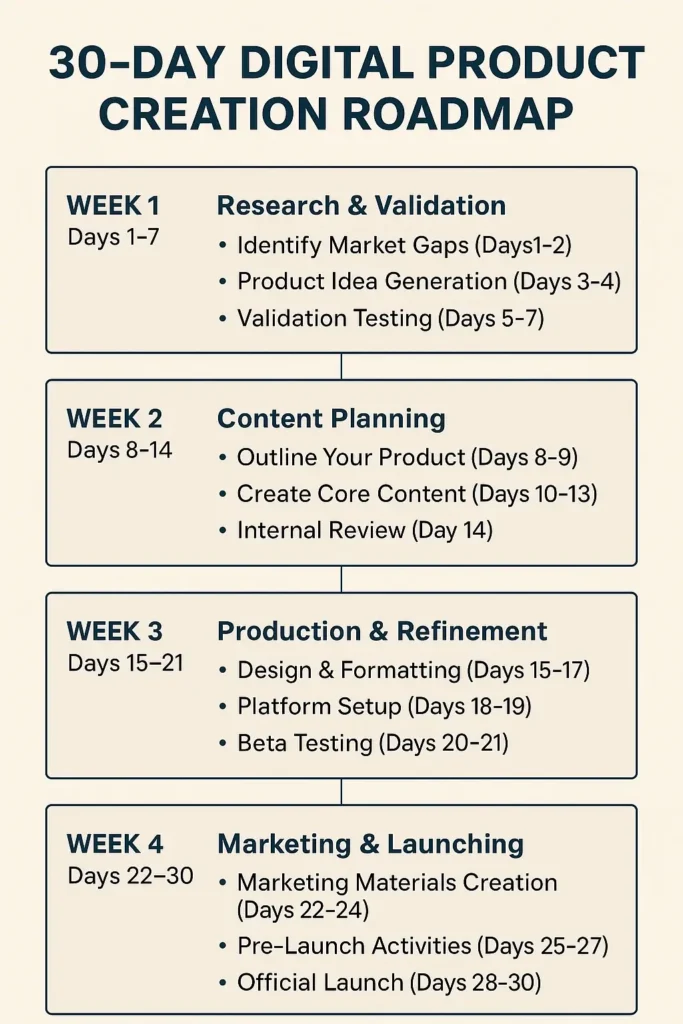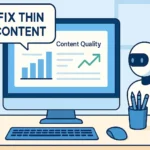Digital Product Creation: From Concept to Cash in 30 Days

Introduction: Transform Your Expertise Into Digital Gold
Digital product creation has become one of the most effective ways for content creators to generate sustainable income online. If you’re tired of relying solely on ad revenue and affiliate commissions, it’s time to explore how turning your knowledge into digital products can unlock powerful, scalable revenue streams.
With the right strategy, you can go from a raw idea to a profitable product in just 30 days—without needing a huge audience or a complex tech stack.
As a content creator myself, I’ve seen firsthand how a single digital product can transform a blog from barely surviving to thriving. In fact, my first product generated more revenue in its launch week than six months of display advertising—and it continued to sell passively with minimal effort.
In this step-by-step guide, I’ll walk you through the entire digital product creation process—from research and validation to launch and beyond. Let’s turn your expertise into a powerful asset that works for you 24/7.
Table of Contents
- Why Digital Product Creation Is a Smart Income Strategy in 2025
- The 30-Day Digital Product Creation Roadmap
- Choosing Your First Digital Product: A Comparison Chart
- Case Study: Sarah’s Food Blog Transformation
- 7 Must-Have Tools for Digital Product Creation
- Pricing Your Digital Products: The 3-Tier Strategy
- Expert Opinions: What Industry Leaders Say
- Common Pitfalls to Avoid
- Beyond the Launch: Sustaining Sales
- Digital Product Repurposing
- FAQ: Digital Product Creation
- Conclusion: Start Your Digital Product Creation Journey
Why Digital Product Creation Is a Smart Income Strategy in 2025
Before diving into the how-to, let’s first look at why digital products should be part of your income diversification strategy:
- Higher profit margins: Digital products typically have 70-90% profit margins compared to 4-10% for physical products.
- Scalability: You can sell to unlimited customers without increasing production costs.
- Passive income potential: Furthermore, once created, products can generate income for years with minimal updates.
- Ownership: Unlike affiliate marketing, moreover, you own the entire customer relationship and all profits.
According to ConvertKit’s 2023 Creator Economy Report, creators who offer digital products earn 2-5x more than those relying solely on ads and affiliate income. If you’re new to monetization, therefore, check out my article on Best Affiliate Programs for Beginners in 2025: Start Earning Today to complement your digital product strategy.
The 30-Day Digital Product Creation Roadmap
Let’s now break down the entire process into four manageable weeks:

Week 1: Research & Validation for Digital Product Creation
Identify Market Gaps (Days 1-2)
- First, analyze your audience’s most common questions
- Then, review blog post comments and social media interactions
- Finally, send a survey to your email subscribers asking about their biggest challenges
Product Idea Generation (Days 3-4)
- Subsequently, list potential digital product types that match audience needs:
- Ebooks and guides
- Online courses
- Templates and swipe files
- Printables
- Software tools/plugins
- Membership programs
Validation Testing (Days 5-7)
- After that, create a simple landing page with product concept
- Next, set up a waitlist or pre-sale opportunity
- Lastly, test different price points with small audience segments
Pro Tip: Never skip validation. According to CB Insights’ Startup Failure Report, the top reason digital products fail is due to lack of market demand. As a result, you should spend 20% of your total time ensuring demand exists.
Week 2: Content Planning for Digital Product Creation
Outline Your Product (Days 8-9)
- Initially, create a comprehensive outline
- Then, break content into logical modules/chapters
- Additionally, identify what media formats will best serve the material
Create Core Content (Days 10-13)
- Afterward, write primary text content
- Meanwhile, record video/audio if applicable
- Simultaneously, design worksheets, templates, or supplementary materials
Internal Review (Day 14)
- At this point, ensure all content aligns with promised outcomes
- Furthermore, check for gaps in information
- In addition, verify logical flow from beginning to end
Week 3: Product Production and Refinement
Design & Formatting (Days 15-17)
- To begin with, create cohesive visual branding
- Following that, format documents professionally
- Consequently, develop presentation slides if needed
Platform Setup (Days 18-19)
- Subsequently, choose your selling platform (Gumroad, Teachable, your own website, etc.)
- As a next step, set up payment processing
- Therefore, create product delivery systems
Beta Testing (Days 20-21)
- As a result, invite 5-10 trusted audience members to review
- Thus, collect detailed feedback
- Finally, make necessary adjustments
Week 4: Marketing & Launching Your Digital Product
Marketing Materials Creation (Days 22-24)
- First of all, write sales page copy
- In addition, create promotional images
- Moreover, develop email sequences
- Furthermore, prepare social media announcements
Pre-Launch Activities (Days 25-27)
- Meanwhile, build anticipation with teaser content
- At the same time, set up affiliate program if applicable
- In contrast, offer early-bird pricing to waitlist
Official Launch (Days 28-30)
- Eventually, open cart with launch discount
- Simultaneously, host live Q&A or webinar
- In conclusion, actively engage with customer questions
Choosing Your First Digital Product: A Comparison Chart
Not sure which type of digital product to create first? Consequently, this comparison chart helps identify the best fit for your situation:
| Product Type | Creation Time | Technical Skill | Price Range | Audience Size Needed | Best For |
|---|---|---|---|---|---|
| Ebook/Guide | 1–2 weeks | Low | $9–$47 | Small–Medium | Beginners, testing concepts |
| Templates/Swipe Files | 3–7 days | Low–Medium | $17–$97 | Any size | Fast creation, proven frameworks |
| Mini-Course | 2–3 weeks | Medium | $37–$197 | Medium | Specific skill teaching |
| Full Course | 3–6 weeks | High | $197–$997 | Medium–Large | Comprehensive solutions |
| Membership | 2–4 weeks initial | High | $7–$97/month | Medium–Large | Recurring revenue |
| Software/Plugin | 4+ weeks | Very High | $27–$497 | Medium–Large | Technical audiences |
Case Study: Sarah’s Food Blog Transformation
Sarah ran a food blog with 50,000 monthly visitors, earning approximately $1,200/month through ads and Amazon affiliate links. However, after identifying that her audience struggled with meal planning, she created a simple digital product:
- Product: 4-Week Meal Planning Bundle with shopping lists and prep guides
- Creation Time: 14 days of focused work
- Investment: $250 for design help
- Launch Results: $7,800 in first-week sales
- Ongoing: Consequently, $2,500-$3,000 in monthly recurring sales
The key to Sarah’s success? Above all, she solved a specific, validated problem her audience was willing to pay to overcome. If you’re just getting started with blogging, similarly check out my complete guide on How to Start a Blog and Make Money in 2025 to build the foundation for your digital product business.
7 Must-Have Tools for Digital Product Creation
The right tools can dramatically reduce creation time and improve product quality:
- Canva Pro ($12.99/month): Specifically, professional design templates for ebooks, workbooks, and promotional materials.
- Teachable (from $39/month): In particular, an all-in-one platform for hosting and selling online courses with integrated payment processing.
- Notion ($8/month): Furthermore, organize product content, track tasks, and collaborate with team members.
- Loom ($8/month): Additionally, record screen tutorials and product demonstrations with ease.
- ConvertKit (from $29/month): An email marketing platform with automated sequences for product launches. Not sure if ConvertKit is right for you? Therefore, read my comparison: ConvertKit vs Mailchimp for Bloggers: Which Email Platform Wins in 2025?
- ThriveCart (one-time $495): Besides that, shopping cart with upsells, affiliates, and subscription capabilities.
- Descript (from $12/month): Finally, edit audio and video content as easily as editing a document.
Pricing Your Digital Products: The 3-Tier Strategy
Pricing can make or break your product launch. Nevertheless, the 3-tier pricing strategy has proven most effective for new creators:
Basic Tier (Entry Point)
- Price Range: Typically, $27-$47
- Content: In essence, core solution only
- Purpose: Primarily, low-risk entry for new customers
Premium Tier (Value Maximizer)
- Price Range: Generally, $67-$147
- Content: Specifically, core solution plus additional resources
- Purpose: Ideally, best value proposition; aim for 60-70% of sales here
VIP Tier (Premium Experience)
- Price Range: Usually, $197-$497
- Content: Overall, everything plus exclusive bonuses and/or personal support
- Purpose: Ultimately, maximize revenue from highest-intent buyers
Pricing Insight: According to digital product marketplace data, products priced between $27-$97 typically see the highest conversion rates (7-15%) for creators with audiences under 10,000 subscribers.
Expert Opinions: What Industry Leaders Say About Digital Product Creation
Pat Flynn, Founder of Smart Passive Income: “The biggest mistake I see creators make is waiting until they have a ‘perfect’ product. Instead, launch with a minimum viable product, then improve based on real customer feedback.”
Amy Porterfield, Online Marketing Expert: “Digital product success comes down to solving a specific problem for a specific person. The more narrowly you define your target customer’s pain point, the easier it is to create a product they’ll buy.”
Melyssa Griffin, Entrepreneur and Educator: “Your first digital product should leverage content you’ve already created. Therefore, look at your most popular blog posts, social content, or podcast episodes—they reveal what your audience already values.”
Common Pitfalls to Avoid in Digital Product Creation
- Complexity overload: First and foremost, creating an overly complex first product that takes months to finish.
- Feature creep: Continuously adding ‘just one more feature’ can delay your launch and overwhelm your audience.
- Perfectionism: Likewise, refusing to launch until everything is flawless.
- Underpricing: Furthermore, setting prices too low based on personal comfort rather than value delivered.
- Neglecting email list: Additionally, failing to build an audience before creating products.
- Poor positioning: Finally, not clearly articulating who the product is for and what problem it solves.
Beyond the Launch: Sustaining Digital Product Sales
The work doesn’t end after launch day. Instead, to create sustainable income:
- Automate testimonial collection from satisfied customers
- Create case studies: Meanwhile, highlight customer success
- Develop evergreen webinar funnels: Subsequently, ensure ongoing sales
- Implement seasonal promotions: For instance, run campaigns 2-4 times yearly
- Update content: Specifically, refresh at least semi-annually
- Build upsell pathways: Consequently, create connections between multiple products
Your email list is the backbone of sustainable sales. To get the most out of it, check out my guide The Ultimate Guide to Monetizing Your Email List in 2025. When promoting your product via email, furthermore, make sure to implement the strategies from How to Increase Email Open Rates by 37% (With These 5 Tools) to maximize your conversion rates.
Global Optimization Tips for Digital Product Creators
Reaching international markets in 2025? These global strategies will help you optimize your digital product for multiple regions.
Regional Legal Compliance
- EU: Implement GDPR-compliant data collection (tools: CookieYes, iubenda)
- California: Ensure CCPA disclosures for US-based customers
- China: Register with the CAC if targeting Chinese users
Localized Payment Preferences
| Region | Preferred Payment Methods |
|---|---|
| Asia | Alipay, PayPay, GrabPay |
| Europe | SEPA, Klarna, iDEAL |
| Latin America | Mercado Pago, OXXO |
Smart Translation & Content Management
- Use DeepL Pro for nuanced translations
- Try Lokalise for managing multilingual content
- For Asia: Prioritize Korean > Japanese > Simplified Chinese
Cultural & UX Adaptation
- Japan: Offer high-ticket products with 1:1 coaching
- Middle East: Ensure right-to-left formatting for Arabic
- Germany: Add detailed technical specs in product pages
Global Tax Considerations
- EU: Register for VAT under the MOSS scheme
- US: Understand sales tax nexus obligations by state
- Australia: Apply GST for digital product sales
Regional Marketing Insights
- Brazil: WhatsApp integration boosts conversion
- India: Include UPI links in email campaigns
- France: Email marketing performs better than social media ads
💬 “We saw 40% higher conversion rates in Germany after adding SEPA payments and localized case studies.”
— Markus Schmidt, Digital Product Coach
Pro Tip: Start with Tier 1 English-speaking markets (US, UK, Canada, Australia), then expand to:
- Asia (Japan, Singapore)
- Western Europe (Germany, France, Spain)
- The Nordics (Sweden, Norway, Denmark)
Digital Product Repurposing: Turn One Offer into Multiple Revenue Streams
Multiply your revenue streams by repurposing your digital product content strategically:
- Extract chapters from an ebook to create lead magnet blog posts
- Turn course modules into engaging YouTube videos with product calls-to-action
- Transform your worksheets into eye-catching Pinterest pins
- Additionally, convert training content into paid workshop sessions
- Finally, use product Q&As to create podcast episodes
A single, well-crafted digital product can power content across all your platforms—while guiding qualified prospects straight to your paid offers.
FAQ: Digital Product Creation
How much money can I realistically make from digital products?
The revenue potential varies widely based on audience size, niche, and product quality. In general, creators with 5,000+ email subscribers typically generate $2,000-$10,000 per launch, with established creators earning $50,000+ from major launches. Nevertheless, the key factor is audience engagement quality, not just quantity.
Do I need a large audience before creating digital products?
No, but you need an engaged audience. Specifically, a highly engaged email list of 500 people can outperform a disengaged list of 10,000. Therefore, focus on building relationships with your existing audience while creating your first product. In fact, many successful creators started with audiences under 1,000 subscribers.
Should I offer a money-back guarantee?
Yes, especially for higher-priced products. Indeed, a 14 or 30-day guarantee reduces purchase risk and typically increases conversion rates by 25-40%. However, the refund rate for well-created digital products generally stays under 5%.
What’s better for a first product: a low-priced ebook or a premium course?
For most creators, starting with a moderately priced product ($27-$97) offers the best balance between effort and return. Specifically, this could be a comprehensive guide, template pack, or mini-course. Furthermore, this price point is high enough to be profitable but low enough to minimize purchase resistance.
How do I protect my digital products from being shared illegally?
While perfect protection is impossible, you can implement reasonable safeguards like watermarking PDFs, using secure course platforms with login requirements, and clearly stating your terms of use. Most importantly, create products so valuable that customers want to support your work rather than share it.
Conclusion: Start Your Digital Product Creation Journey
Creating profitable digital products isn’t about having the largest audience or the most sophisticated tools—it’s about efficiently solving specific problems for a specific audience.
By following this 30-day roadmap, you can, therefore, transform your expertise into income-generating assets that work for you 24/7. First, start small; then, focus on validation; and finally, deliver exceptional value. Your first digital product is often the hardest—but it’s also the one that transforms your mindset from blogger to entrepreneur.
Ready to take your content business to the next level? Consequently, join my Telegram channel “BloggingRevenue” for weekly insights on digital product creation and monetization strategies. Or alternatively, check out my related articles on sales funnel creation and email marketing automation to support your product launches.
Your next step: Above all, choose one audience pain point and start the validation process this week. After all, the sooner you begin, the sooner you’ll have a profitable digital product in your portfolio!








